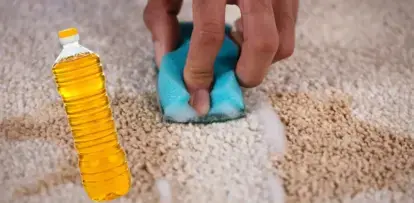
How to Get Oil Out of Carpet: COIT’s Stain Removal Guide
Contact COIT for a professional cleaning!
Anyone who’s ever spilled oil on a carpet knows just how tricky oil stain removal can be.
No matter how hard we try, accidents happen. Whether the result of spilled cooking oil or motor oil brought in from the outside via someone’s shoes, oil stains on carpets can be particularly stubborn, and removing them requires specific methods and treatments.
When it comes to oil stains, the most important thing to do is act quickly. While removing the stain helps to maintain a fresh appearance, removal is also important to preserve the integrity of your carpet. if given the time to set, an oil stain will seep into carpet fibers and become more stubborn or potentially cause permanent damage. Not to mention, set-in-oil stains can attract and lock in dust and debris, which contributes to an accumulation of unwanted filth in the home.
To combat oil stains and promote healthy living environments, this article will provide homeowners with a step-by-step stain removal guide on how to effectively remove oil from carpets along with general carpet cleaning tips to keep them fresh and increase their lifespan.
Understanding Oil Stains
Unlike other stains, oil stains cling to carpet fibers and are considered hydrophobic, or water-repellent. Because oil and water won’t mix, and most stain removers are water-based, this makes getting rid of oil stains a bit more challenging—but not impossible!
When oil seeps into carpet fibers, it leaves behind a greasy residue and can cause the affected area to lose its soft texture and become stiff over time. In addition to this texture change, neglected oil stains, which often go rancid, can carry unpleasant odors that may linger or permeate throughout the home.
DIY Methods to Remove Oil from Carpet
When removing an oil stain, it’s important to consider two things: the type of carpet you own and the type of oil stain.
Certain carpet types, such as wool, will need to be treated more delicately than a durable, synthetic carpet, which has stain-resistant qualities and can withstand more wear and tear. On a similar note, common types of oils that stain carpets include cooking oils (such as olive oil, vegetable oil, canola oil, etc.), motor oil, and even hair products or body oil. Each of these oils is made up of different ingredients and needs to be treated accordingly to effectively break down the stain.
While the type of carpet and stain will help you determine how to best proceed in removing the spot, below we will address general tips and basic procedures to remove the most common oil stains from your carpet. For household cleaning tips and how to address specific stains, visit our Stain Removal Guide.
How to Remove an Oil Stain From Carpet
Method #1: Cooking Oil
- Using a dry paper towel, blot the oil stain until no more oil appears on the paper towel. Be sure not to rub, as this can cause the stain to seep deeper into the fibers.
- Next, take a washcloth and apply small amounts of rubbing alcohol directly onto the oil stain.
- Mix 1 quart of water with ¼ teaspoon of dishwashing liquid (one that doesn’t contain lanolin or bleach).
- With a sponge, apply the mixture directly onto the stain.
- Blot the affected area of the carpet until the oil stain is no longer visible.
Method #2: Motor Oil
- Gently scrape off any excess oil with a butter knife, careful not to damage any carpet fibers,
- Sprinkle a generous amount of baking soda or cornstarch directly onto the motor oil stain and allow it to sit for at least 10 minutes.
- Vacuum up the powder.
- Apply a few drops of dry-cleaning solvent on a clean cloth and apply the cloth directly to the stain.
- Blot the stain with a clean cloth. If the oil stain is still visible, mix 2 cups of warm water with 1 tablespoon of white vinegar and 1 tablespoon of liquid dishwashing detergent.
- Using a sponge, apply this solution, working it into any remaining oil stain residue.
- Rinse the area with cold water and let it dry.
Dealing with Set-In Oil Stains
If you’re dealing with an oil stain that’s deeply set, it may require a bit more work to fully remove the spot. Although fresh oil stains that are treated promptly can be removed with ingredients you likely already have in your own home, set-in stubborn stains may require stronger, commercial-grade cleaning agents that can penetrate carpet fibers and break down the oil molecules.
If using a commercial cleaner, be sure to read the instructions carefully before using, and adhere to directions to avoid further damaging your carpet. Depending on the type of cleaner you’ve purchased, you can also use a soft bristle brush to gently work the cleaning agent further into the carpet so that it fully penetrates the fibers and breaks down the oil molecules.
Professional Oil Stain Removal Services
Stain removal of any kind can be daunting. For oil stains especially, which are trickier by nature, the removal process is even more challenging. When it comes to proper stain removal, it’s essential to get it right the first time, or else you run the risk of creating an even greater (and potentially more expensive) problem. If you’re not confident in the DIY carpet cleaning methods, forgo the trial and error and go directly to the pros.
Being in the professional carpet cleaning business for nearly 75 years, we understand the importance of maintaining a clean, fresh carpet. We also understand that installing a new carpet can be a tedious and costly endeavor. At COIT, we believe in renewing carpets before replacing them, and we do everything in our power to remove stains to your satisfaction—that’s our guarantee.
Our cleaning services also include our CoitGard™ stain protector for carpets and area rugs to repel oil- and water-based stains on all types of carpets. Our technicians are well-equipped and expertly trained to determine which treatment and technique is best for your specific carpet type.
Contact COIT today for professional carpet cleaning services.
Frequently Asked Questions
Q: How long does it take for oil to set in?
A: While this will depend on the type of oil, it is likely set once it’s dried. After it’s dry, it will become more difficult to break down the oil molecules and lift the stain. For these reasons, it’s imperative to tend to the stain as soon as possible to avoid permanent damage to your carpet.
Q: Can oil stains cause permanent damage to carpets?
A: Yes, oil stains can cause permanent damage to carpets if left untreated. After oil dries, it can harden and alter your carpet’s soft texture. Not to mention, some oils are food-based and can go rancid, which will leave behind a foul odor.
Q: Is it safe to use homemade cleaning solutions on all carpet types?
A: Although homemade cleaning solutions are a great, cost-effective means of cleaning carpets with ingredients you can find at home, you will want to do a bit of research beforehand to determine what’s best for your carpet type. For example, wool carpets aren’t as durable as synthetic carpets and require a gentler solution.
Q: What should I do if the oil stain won’t come out?
A: If an oil stain won’t come out, you have a few options. For one, consider using a commercial-grade cleaning solution if you haven’t done so already. These are stronger than other solutions and can penetrate carpet fibers more easily. If the stain persists, it might be time to contact a professional carpet cleaning service to address the stain head-on.
Explore more stain removal tips on our Blog.
Recap and Key Takeaways
Given their water-repellent properties, oil stains are among the hardest to remove. When it comes to oil stain removal, timeliness is key. The quicker you act, the more likely you will be able to remove the stain on your own. Even then, you will want to take the time to consider not only the type of oil stain, but also the type of carpet you own.
To take the guesswork out of stain removal and avoid damaging your carpet, call COIT.
Schedule a free consultation with COIT’s carpet cleaning experts.



